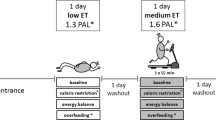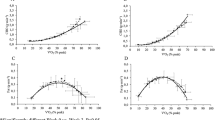Abstract
OBJECTIVE: To investigate the effect of prolonged adaptation to training and fat- or carbohydrate-rich diet on body composition and insulin resistance.
DESIGN: Longitudinal study. Of three groups two consumed a fat-rich diet, of which one performed regular training (FAT-Train, n=17) and the other maintained normal habitual activity (Fat-Control, n=8). The third group trained and consumed a carbohydrate-rich diet (CHO-Train, n=16).
SUBJECTS: Forty-one untrained, healthy male subjects.
MEASUREMENTS: Before and after 7 weeks body composition was estimated from skinfold measurements. At rest the respiratory exchange ratio (RER) was determined by the Douglas bag technique. Glycogen was determined in m vastus lateralis and concentrations of insulin and triacylglycerol in serum and glucose, fatty acid and beta-hydroxy-butyrate in plasma was measured. The insulin resistance index was calculated from fasting plasma insulin and glucose values.
RESULTS: Across the 7 weeks body weight was reduced (1.3±0.3%) in all three groups, however body fat mass was decreased only in the CHO-Train (13%) and maintained in the two FAT-groups. RER at rest was similarly decreased (5%) in the three groups. Plasma insulin tended to decrease (16%) in CHO-Train (P=0.065) and remained unchanged in the two FAT-groups. In contrast plasma glucose (4.6±0.1 mmol/l) and plasma FA (453±27 µmol/l) remained unchanged across the 7 weeks. The calculated insulin resistance index HOMA-Rmod was significantly decreased by 19% in CHO-train but remained unchanged in both of the FAT-groups, whereas the calculated insulin secretion index HOMA-ßmod was unchanged in all three groups.
CONCLUSION: In the present study we demonstrate that despite of a mild energy deficit body fat mass was maintained after prolonged adaptation to fat-rich diet both when normal physical activity was maintained and when training was performed. In contrast a significant decrease in fat mass was observed when carbohydrate-rich diet and training was combined. Furthermore we observed that the insulin resistance index was significantly decreased only when training was combined with a carbohydrate-rich diet.
This is a preview of subscription content, access via your institution
Access options
Subscribe to this journal
Receive 12 print issues and online access
$259.00 per year
only $21.58 per issue
Buy this article
- Purchase on Springer Link
- Instant access to full article PDF
Prices may be subject to local taxes which are calculated during checkout

Similar content being viewed by others
References
Popkin BM, Doak CM . The obesity epidemic is a worldwide phenomenon Nutr Rev 1998 56: 106–114.
Flatt JP . Dietary fat, carbohydrate balance, and weight maintenance: effects of exercise Am J Clin Nutr 1987 45: 296–306.
Willett WC . Is dietary fat a major determinant of body fat? Am J Clin Nutr 1998 67: 556S–562S.
Bray GA, Popkin BM . Dietary fat intake does affect obesity! Am J Clin Nutr 1998 68: 1157–1173.
Dela F, Ploug T, Handberg A, Petersen LN, Larsen JJ, Mikines KJ, Galbo H . Physical training increases muscle GLUT4 protein and mRNA in patients with NIDDM Diabetes 1994 43: 862–865.
Mikines KJ, Richter EA, Dela F, Galbo H . Seven days of bed rest decrease insulin action on glucose uptake in leg and whole body J Appl Physiol 1991 70: 1245–1254.
Richter EA, Kristiansen S, Wojtaszewski J, Daugaard JR, Asp S, Hespel P, Kiens B . Training effects on muscle glucose transport during exercise Adv Exp Med Biol 1998 441: 107–116.
Feskens EJM, Kromhout D . Habitual dietary intake and glucose tolerance in euglycemic men: the Zutphen study Int J Epidemiol 1997 19: 953–959.
Marshall JA, Hoag S, Shetterly S, Hamman RF . Dietary fat predicts conversion from impaired glucose tolerance to NIDDM Diabetes Care 1997 17: 50–56.
Yost TJ, Jensen DR, Haugen BR, Eckel RH . Effect of dietary macronutrient composition on tissue-specific lipoprotein lipase activity and insulin action in normal-weight subjects Am J Clin Nutr 1998 68: 296–302.
Cutler DL, Gray CG, Park SW, Hickman MG, Bell JM, Kolterman G . Low-carbohydrate diet alters intracellular glucose metabolism but not overall glucose disposal in exercise-trained subjects Metabolism 1995 44: 1264–1270.
Bisschop PH, de M, etz J, Ackermans MT, Endert E, Pijl H, Kuipers F, Meijer AJ, Sauerwein HP, Romijn JA . Dietary fat content alters insulin-mediated glucose metabolism in healthy men Am J Clin Nutr 2001 73: 554–559.
Lindgarde F, Saltin B . Daily physical activity, work capacity and glucose tolerance in lean and obese normoglycaemic middle-aged men Diabetologica 1981 20: 134–138.
World Health Organization. Energy and protein requirements. Report of a joint FAO/WHO/UNU expert consultation. Technical Report Series 724 1985.
Bergström J . Muscle electrolytes in man: determined by neutron activation analysis on needle biopsy specimens. A study on normal subjects, kidney patients and patients with chronic diarrhea Scand J Clin Lab Invest 1962 68 (Suppl): 11–13.
Pollack M, Schmidt D, Jackson A . Measurement of cardio-respiratory fitness and body composition in the clinical setting Compr Ther 1980 6: 12–27.
Wieland O . Glycerol assay In: Bergmeyer HV (ed.) Methods of enzymatic analysis. Academic Press: New York 1974 1404–1406.
Kiens B, Lithell H . Lipoprotein metabolism influenced by training-induced changes in human skeletal muscle J Clin Invest 1989 83: 558–564.
Siri WE . Body composition from fluid spaces and density In: Brotzek JHA, Hnaschel A (eds) Techniques for measuring body composition. National Academy of Sciences: Washington, DC 1961 223–224.
Matthews DR, Hosker JP, Rudenski AS, Naylor BA, Treacher DF, Turner RC . Homeostasis model assessment: insulin resistance and beta-cell function from fasting plasma glucose and insulin concentrations in man Diabetologia 1985 28: 412–419.
Jenkins AB, Samaras K, Carey DG, Kelly P, Campbell LV . Improved indices of insulin resistance and insulin secretion for use in genetic and population studies of type 2 diabetes mellitus Twin Res 2000 3: 148–151.
Coulston AM, Liu GC, Reaven GM . Plasma glucose, insulin and lipid responses to high-carbohydrate low fat diets in normal humans Metabolism 1983 32: 52–56.
Borkman M, Campbell LV, Chisholm DJ, Storlien LH . Comparison of the effects on insulin sensitivity of high carbohydrate and high fat diets in normal subjects J Clin Endocrinol Metab 1991 72: 432–437.
Phinney SD, Bistrian BR, Evans WJ, Gervino E, Blackburn GL . The human metabolic response to chronic ketosis without caloric restriction: preservation of submaximal exercise capability with reduced carbohydrate oxidation Metabolism 1983 32: 769–776.
Calles-Escandón J, Goran MI, O'Connell M, Nair KS, Danforth E Jr . Exercise increases fat oxidation at rest unrelated to changes in energy balance or lipolysis Am J Physiol 1996 270: E1009–E1014.
Poehlman ET, Gardner AW, Arciero PJ, Goran MI, Calles EJ . Effects of endurance training on total fat oxidation in elderly persons J Appl Physiol 1976 2281–2287.
Flatt JP . Dietary fat, carbohydrate balance, and weight maintenance Ann N Y Acad Sci 1987 683: 122–140.
Shepard TY, Weil KM, Sharp TA, Grunwald GK, Bell ML, Hill JO, Eckel RH . Occasional physical inactivity combined with a high-fat diet may be important in the development and maintenance of obesity in human subjects Am J Clin Nutr 2001 73: 703–708.
Zierath JR, Houseknecht KL, Gnudi L, Kahn BB . High-fat feeding impairs insulin-stimulated GLUT4 recruitment via an early signalling defect Diabetes 1997 46: 215–223.
Shepherd PR, Kahn BB . Glucose transporters and insulin action—implications for insulin resistance and diabetes mellitus New Engl J Med 1999 341: 248–257.
Storlien LH, Baur LA, Kriketos AD, Pan DA, Cooney GJ, Jenkins AB, Calvert GD, Campbell LV . Dietary fats and insulin action Diabetologica 1996 39: 621–631.
Helge JW, Richter EA, Kiens B . Interaction of training and diet on metabolism and endurance during exercise in man J Physiol (Lond) 1996 292: 293–306.
Acknowledgements
The skilled technical assistance of Irene Bech Nielsen, Nina Pluzek, Ingelise Kring, Betina Bolmgren, Winnie Tågerup and Hanne Vig Kryger is acknowledged. The study was supported by grants from the Danish National Research Foundation grant no. 504-14, the Danish Research Academy (no. 77-7711), Team Danmark and the Danish Sports Research Council (no. 94-1-09).
Author information
Authors and Affiliations
Corresponding author
Rights and permissions
About this article
Cite this article
Helge, J. Prolonged adaptation to fat-rich diet and training; effects on body fat stores and insulin resistance in man. Int J Obes 26, 1118–1124 (2002). https://doi.org/10.1038/sj.ijo.0802058
Received:
Revised:
Accepted:
Published:
Issue Date:
DOI: https://doi.org/10.1038/sj.ijo.0802058
Keywords
This article is cited by
-
The prevalence of metabolic syndrome and its predominant components among pre-and postmenopausal Ghanaian women
BMC Research Notes (2013)
-
Muscle ceramide content is similar after 3 weeks’ consumption of fat or carbohydrate diet in a crossover design in patients with type 2 diabetes
European Journal of Applied Physiology (2012)



